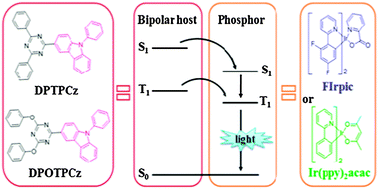Novel bipolar host materials based on 1,3,5-triazine derivatives for highly efficient phosphorescent OLEDs with extremely low efficiency roll-off
Abstract
Recently, bipolar host materials have attracted considerable attention because they can achieve balanced charge injection/transport in phosphorescent organic light emitting diodes (PhOLEDs) and consequently obtain excellent device performance. In this work, two bipolar host materials, namely, 3-(4,6-diphenyl-1,3,5-triazin-2-yl)-9-phenyl-9H-carbazole (DPTPCz) and

- This article is part of the themed collection: Organic electronics - new physical chemistry insight

 Please wait while we load your content...
Please wait while we load your content...